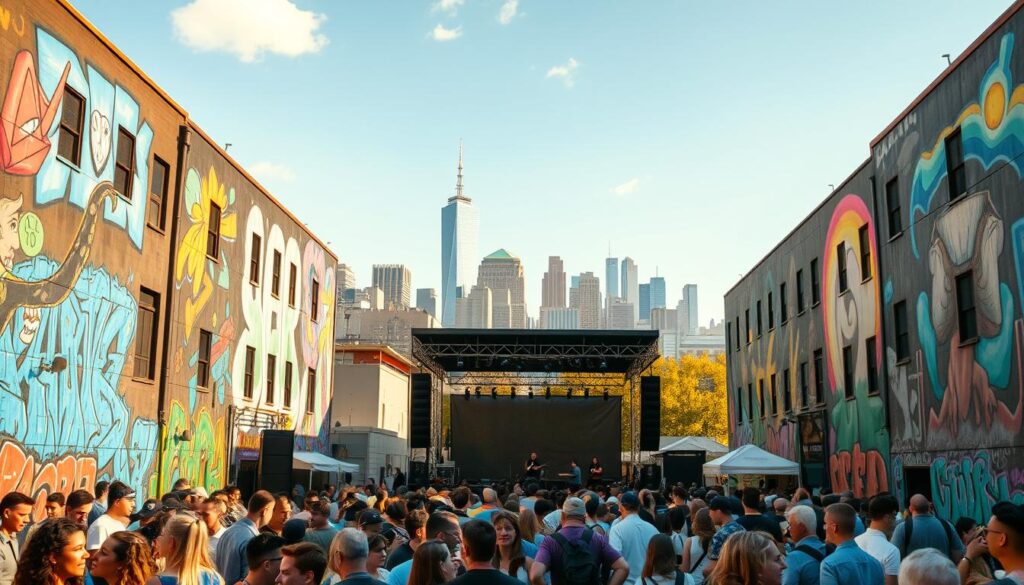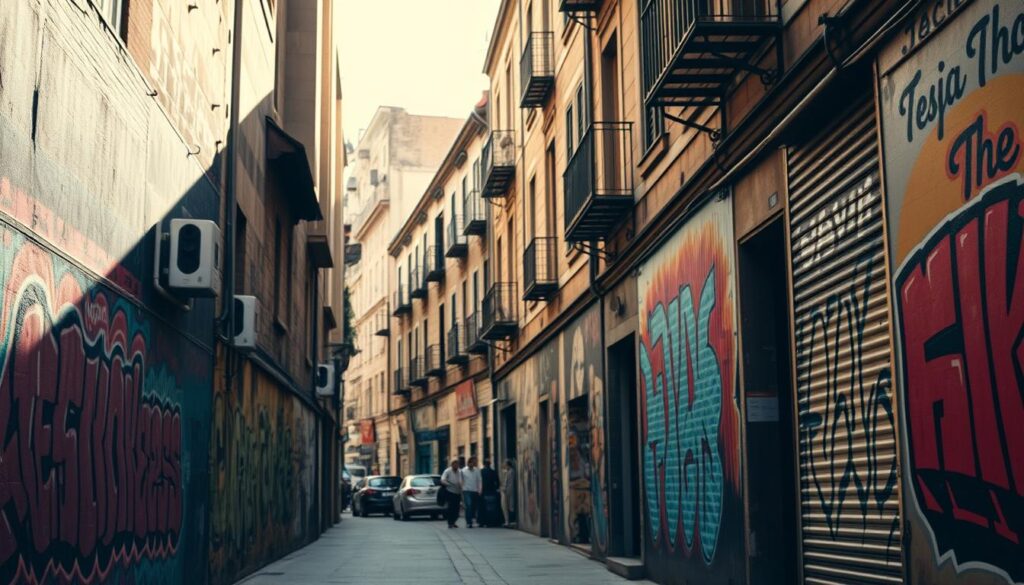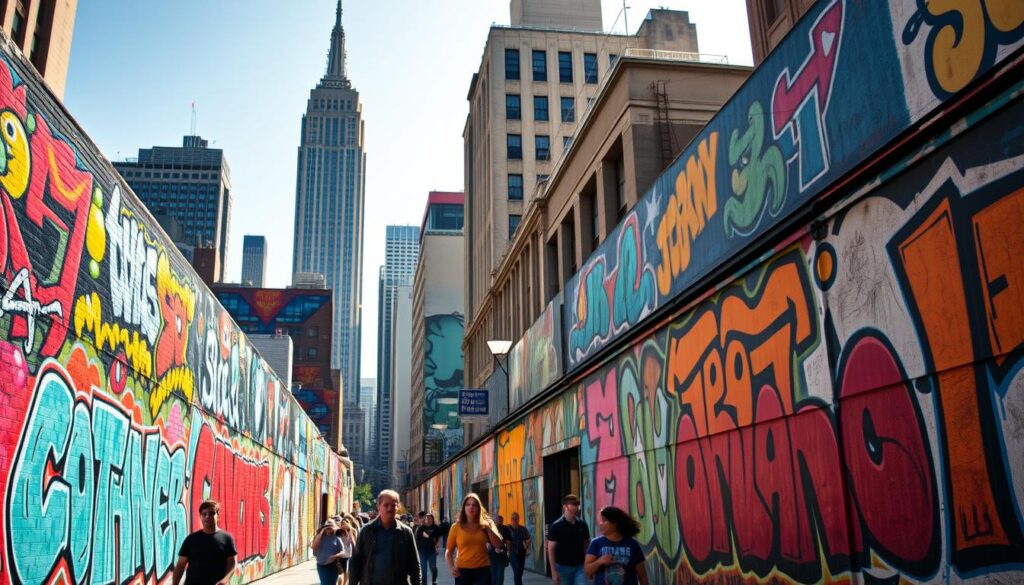Existent research confirms that public artwork attracts over 75 percent of tourists to specific destinations. Urban murals together with graffiti transformed from simple decorative elements into reflections which directly represent urban culture and civic personality. People of all backgrounds will make these living galleries their absolute must-see destinations because they present essential narratives which connect locals with tourists.
Public art transforms ordinary locations into specific places for participation by transforming metropolitan areas and residential districts. Public works establish visual beauty by presenting genuine accounts derived from community roots and their hardships as well as their future goals. The locations offer a distinctive artistic union between historical styles and contemporary art for people attracted to artistic expressions.
The museums along with cultural events and local-based initiatives and artistic walking programs enable urban centers to preserve their artistic heritage. These initiatives showcase artistic abilities through their delivery of local pride development to community members within the area. From any perspective this new contemporary art environment provides promising views of the worldwide environment to both professionals and newbies.
Key Takeaways
- Art within municipalities exists in various forms outside traditional boundaries because it reflects both identity and fundamental qualities of urban heritage.
- When cities implement public art applications they obtain a functional operational mode that benefits locals together with visitors.
- Multiple artistic organizations successfully merge classical archaeological design elements with progressive artistic methods in parallel structures.
- Artistic heritage in capital cities finds its celebration through festivals as well as touring activities.
People find an extraordinary and rewarding experience during their exploration of urban art.
Introduction to the World of Urban Street Art
The current urban transformation consists of using street artwork as both political expressions and cultural connectives through urban development projects. Graffiti art evolved into an international movement which now beautifies typical structures with vibrant artistic designs. The artistic elements go beyond cosmetic function because they develop into narrative forces which deliver meaning through the canvas.
The Rise of Urban Murals and Graffiti
Street art arises from the initial graffiti movement between Philadelphia and New York when they were developing in the early 1980s. Street art has risen to become an honorable art form since mural paintings have become an integral part of urban public spaces. Artworks in street art depict the combined everyday life events of communities along with their cultural expression and dream representations.
Street graffiti started in Bogota through political turmoil because citizens wanted unheard messages to be broadcast. Historical sites within Lisbon merged into artistic creations as they received color transformations that merged historical components with artistic masterpieces. People and social groups use street art today as an expression tool to communicate emotions.
Cultural Significance and Community Impact
Among all aspects of street art its aesthetic appeal stands as a single element that leads to community bonds. The historical information contained in mural art creates public areas into natural exhibition spaces alongside graffiti creation. The artistic expression in La Candelaria enables people to promote community unity and cultural pride.
These works display their exhibition space primarily in urban construction sites where artists unite modern city views with elements that depict history creatively. The process of restructuring leads to picturesque urban development and strengthens community cohesion in residential areas. Artistic items on public spaces show that creative talents construct beneficial communities.
People pursue art by making visits to street art capitals throughout the world.
City locations host domestic and international artists who use their facilities as outdoor exhibition areas. People who live in urban areas together with seekers of observation find fascination in the extensive wall paintings and meticulous inscriptions that present stories about the city. The individual characteristics of particular areas appear in each artwork that functions as mandatory stops for people interested in public art.
Iconic Cities and Must-See Murals
The development of international street art reputation within cities resulted from innovative city development practices. A massive mural extends from one corner of the block to the next making it a major tourist destination in Buenos Aires. Artistic energy within the wall painting establishes a perfect connection to the historical and cultural heritage of the city.
Cape Town’s urban environment presents various eye-catching wall artworks that bring forth social and political discussions. The urban art works in the city fulfill two objectives through visual enhancement of locations and generating essential discussions among community members. Modern artists and established talent use these public areas as their exhibition venues.
Local Artists and Their Unique Stories
Every wall painting depicts the artistic journey of the artist in its creative creation. Artists around Bogota decide to use their creative works as tools that explore themes related to identity and resilience. Through their unique perspective the artists produce fresh art that stimulates neighborhood rejuvenation.
People understand artistic perspectives best when they join local artistic activities to discover authentic stories. Those who study public art find out about artistic challenges and concept origins as they examine various works displayed throughout their travels. Linking art with community helps create better understanding of art while preserving the social representation of community members.
Urban designers must develop proper exhibition methods for these works. The dimensions of murals are constrained by the width of streets in addition to small artwork installations fitting well into narrow passageways. The planned placement of artwork enhances the enjoyment level because it allows visitors to discover new elements in each part of the area.
Diverse Global Urban Art Scenes
Public art landscapes worldwide exhibit full cultural diversity based on their native heritage. Every corner of the Americas, Europe, Asia and Africa incorporates unique elements when it comes to presenting public art displays. Through creative city art urban environments obtain a visual enhancement which also produces locations that enable people to establish connections between themselves and their environment.
| Region | Key Cities | Cultural Impact |
|---|---|---|
| Americas | Bogota, Buenos Aires, Cape Town | Resilience, identity, socio-political narratives |
| Europe | Lisbon, Berlin, London | Historical storytelling, contemporary creativity |
| Asia & Africa | Mumbai, Nairobi, Johannesburg | Social issues, cultural celebration, community pride |
North and South American Innovations
Urban art stands as the primary storytelling method used by people from the Americas to express historical contents in their public areas. The mural artwork in Bogota reveals both strong historical past and traditional roots while Buenos Aires stands out for its massive block-scale mural production. The artwork functions above artistical purpose by demonstrating its commitment to support local heritage and cultural elements.
The public walls throughout Cape Town display uplifting murals that help society understand political and social issues. Through its activation process the artwork develops community dialogue which enables neighborhoods to operate as modern open-air gallery spaces. Every one of these cities proves that artistic thinking turns dull public environments into dynamic neighborhoods through metamorphic development.
European Evolution of Street Art
Urban art throughout the Americas makes storytelling its powerful method to convey messages. Bogota’s colorful wall art displays provided Bogota with an impression of urban state power along with Buenos Aires obtaining the world record for mural size with its extended block-size artwork. The urban creations of artists convert artwork into sculptural expressions that celebrate both culture and history of their local community.
Social and political matters become the focus of public artwork throughout the streets of Cape Town. The artwork functions both as public conversation spaces while showing the community to audiences. These metropolitan areas gain power through street art because their communities build their strength through artistic transformation.

Emerging Art Hubs in Asia and Africa
Urban art functions as a common artistic trend across Asian and African territories. Public buildings in Mumbai along with African capital Nairobi use murals to solve social challenges as well as display conventional cultural elements. Urban art at this moment is revitalized through fresh viewpoints emanating from developing centers which brings forth new global art perceptions.
Different art installations across Johannesburg are creating dynamic living spaces out of former abandoned land sites. These projects reveal how artistic interventions lead to community unity and community spirit growth between people.
Fival Highlights and Urban Art Events
Every summer Norway presents its internationally recognized Nuart Festival in Stavanger to all visitors. Multiple artists stationed in both regional and worldwide locations use their artworks to create an outdoor gallery whose compositions transform the city into a collective piece of art. Each artwork presented during the festival carries important meanings as they express the location’s one-of-a-kind features.
The key festivals beyond these events comprise Upfest in Bristol as well as Meeting of Styles in Germany. The events work toward street art development alongside better community participation. Visitors tend to remember the significant unique projects that take place throughout these festival days.
From Graffiti to Community Narratives
Graffiti gave birth to street art during the 1970s as an anti-establishment art expression that emerged in New York and Philadelphia. During the 1970s public vandalism shifted toward art expression to become an international artistic movement. The civil disturbance in Bogotá created a space where oppressed groups used street art as their new outlet of expression.
Progressive changes reached a significant level in Lisbon during the democratic revolution period. Urban artists in the city capitalized on vacant walls to build artwork that united preservation values with innovative artistic methods. The urban artworks installed throughout their specific haus managed to merge aesthetic urban improvement with maintaining cultural narratives.
The contemporary culture recognizes street art as an official discipline under its artistic categories. Murals together with graffiti serve artists as tools to promote social change while they visualize struggles and aspirations through their creative works. Time has converted illegal urban graffiti into organized collections representing historical developments.
Art during critical periods of history forms the foundation of public expression as defined art. From Bogotá’s vibrant murals to Lisbon’s intricate designs, these works showcase the evolution of urban painting. The artwork showcases its role in territorial modification as well as neighborhood formation processes.
Street art has developed according to fundamental historical events that served as its essential driving forces. Through murals creativity expresses its power while handling the representation of cultural events and relevant political matters. The artistic creations evolved to establish themselves as a worldwide action that supports cities in every corner of the globe.

Comparing Self-Guided and Organized Tourist
Visitors determine their experience with urban art through choosing between experienced learning or finding things out by themselves. Self-guided tourists reach their destinations freely since they make their own route decisions with no tour restrictions. Through digital presentations visitors can view street artworks in high detail while people across the globe can witness its presentation.
| Tour Type | Benefits | Best For |
|---|---|---|
| Self-Guided | Flexibility, personal pace, cost-effective | Independent explorers |
| Organized | Expert insights, historical context, group interaction | Those seeking deeper understanding |
When visiting with guided tours visitors get complete information about the historical facts that describe all artwork featured in the exhibition. Tour guides share visitors both historical information and cultural meaning about each artwork displayed at the site. The two distribution methods make it possible for people to explore the hidden aspects beneath the surface of urban environments.
The cultural approach of urban art enables both artistic tours along with festival activities that unite audiences. The celebrations enhance public art appreciation through bringing local artistic elements that drive stronger enthusiasm and creative interest for event visitors.
Historical Evolution of Street Art and Murals
Modern cultural elegance demonstrates an extraordinary progression of this phenomenon since its rebellious origins. The practice of graffiti started as artists created simple text but it turned into a significant storytelling method that community builders use as demonstrated in this Twitter message. Street art transformed from rebellious displays into outdoor art exhibitions which gained cultural recognition throughout the previous few decades.
Practical Tips for Exploring Urban Art Destinations
At urban artistic sites visitors can find an amazing chance to experience creative individuality along with cultural ties. The guidelines serve as a useful reference for travelers who are experienced and those who are new to help them succeed in their urban experiences. When visiting public art depend on proper planning of your journey while practicing respect towards local customs through these below guidelines.
Preparing Your Street Art Excursion Properly
You should research every street location in the city which displays its most prominent graffiti and mural art. Public support from agencies in Bogota and other nations enables artists to obtain police protective benefits while producing art. The combination of local guides and applications directs travelers to discover the most suitable sites while permitting them to create an adaptable itinerary.
Conclusion
Visitors can explore city personality through temporary dynamic colorful street paintings which exist for brief intervals at street art capital locations worldwide. Every location acquires its unique graffiti aesthetic through wall artwork that displays cultural stories as well as political dialogues while including historical events and sociological components of identity.




